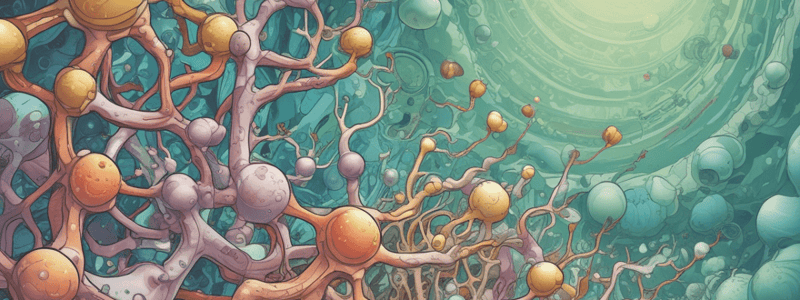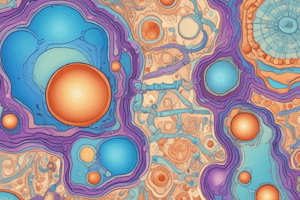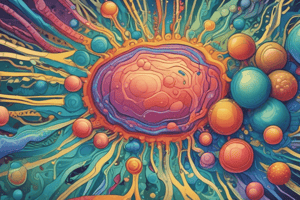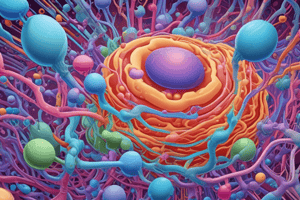Podcast
Questions and Answers
Which of the following transporters has a low affinity for glucose?
Which of the following transporters has a low affinity for glucose?
- GLUT1
- GLUT2 (correct)
- GLUT4
- GLUT3
In which tissues is GLUT1 abundant and GLUT4 scarce?
In which tissues is GLUT1 abundant and GLUT4 scarce?
- Neurones and adipocytes
- Liver and pancreatic ß-cells
- Erythrocytes and skeletal muscle (correct)
- Muscle and erythrocytes
What is the primary function of GLUT2 in pancreatic ß-cells?
What is the primary function of GLUT2 in pancreatic ß-cells?
- Regulate blood glucose levels
- Transport glucose into pancreatic ß-cells when blood glucose is high (correct)
- Transport glucose out of pancreatic ß-cells
- Increase glucose uptake in response to insulin
What is the effect of insulin on GLUT4?
What is the effect of insulin on GLUT4?
What is the primary mechanism of ion channel gating?
What is the primary mechanism of ion channel gating?
What is the effect of insulin on glucose uptake in muscle and adipose tissue?
What is the effect of insulin on glucose uptake in muscle and adipose tissue?
What is the primary distinguishing feature of small-molecule transfer across membranes by active transport?
What is the primary distinguishing feature of small-molecule transfer across membranes by active transport?
Which of the following molecules can freely cross the membrane by simple diffusion?
Which of the following molecules can freely cross the membrane by simple diffusion?
What is the role of the Na+/K+-ATPase membrane pump?
What is the role of the Na+/K+-ATPase membrane pump?
Which type of transport requires a membrane protein, such as an ion channel?
Which type of transport requires a membrane protein, such as an ion channel?
What is the relationship between the Partition Coefficient of a solute and its rate of diffusion?
What is the relationship between the Partition Coefficient of a solute and its rate of diffusion?
What is the function of the GLUT family of glucose transporters?
What is the function of the GLUT family of glucose transporters?
What is the significance of the Km in transporter affinity?
What is the significance of the Km in transporter affinity?
What is the primary difference between facilitated diffusion and active transport?
What is the primary difference between facilitated diffusion and active transport?
Which of the following is an example of secondary active transport?
Which of the following is an example of secondary active transport?
What is the term for the selective permeability of membranes to certain molecules?
What is the term for the selective permeability of membranes to certain molecules?
What is the primary function of the Na+/K+ pump in nerve cells?
What is the primary function of the Na+/K+ pump in nerve cells?
What type of transport occurs when two solutes move in the same direction across a membrane?
What type of transport occurs when two solutes move in the same direction across a membrane?
What is the result of inhibiting the Na+/K+ pump in heart muscle cells?
What is the result of inhibiting the Na+/K+ pump in heart muscle cells?
What is the function of the CFTR protein in cells responsible for producing mucus, sweat, saliva, and tears?
What is the function of the CFTR protein in cells responsible for producing mucus, sweat, saliva, and tears?
What is the purpose of oral rehydration therapy in treating cholera?
What is the purpose of oral rehydration therapy in treating cholera?
What type of transport is facilitated by the Na+/K+ pump?
What type of transport is facilitated by the Na+/K+ pump?
What is the result of the Na+/Ca2+ cotransporter in muscle cells?
What is the result of the Na+/Ca2+ cotransporter in muscle cells?
What is the role of the phosphorylation step in the Na+/K+ pump?
What is the role of the phosphorylation step in the Na+/K+ pump?
What is the effect of digitoxin on the Na+/K+ pump?
What is the effect of digitoxin on the Na+/K+ pump?
What is the mechanism by which SGLUT transports glucose into cells?
What is the mechanism by which SGLUT transports glucose into cells?
Study Notes
Membrane Transport
- Membranes are selective permeability barriers, blocking the passage of almost all hydrophilic molecules into cells and organelles.
- Small uncharged or hydrophobic molecules can freely cross the membrane by simple diffusion along their concentration gradients.
- Charged polar molecules require specialist proteins (pumps, transporters, pores) to allow them to cross the membrane.
Molecules Crossing Membranes
- Hydrophobic molecules that can freely cross the membrane include O2, N2, CO2, benzene, and short-chain fatty acids.
- Small uncharged polar molecules that can cross the membrane include H2O, urea, and glycerol.
- Large uncharged polar molecules that cannot cross the membrane include glucose, sucrose, and ions like H+, Na+, Mg2+, HCO3-, K+, Ca2+, and Cl-.
- Charged polar molecules that cannot cross the membrane include amino acids and ATP.
Mechanisms of Transport
- Passive transport: solutes move down a concentration gradient, crossing the membrane.
- Facilitated diffusion: solutes move down a concentration gradient, crossing the membrane with the help of a transport protein.
- Gated ion channels: ion channels that allow facilitated diffusion, selective for different ions, open or close in response to a stimulus.
- Primary active transport: solutes move against a concentration gradient, requiring energy from ATP hydrolysis.
- Secondary active transport: solutes move against a concentration gradient, using energy from the electrochemical gradient established by primary active transport.
Passive Transport
- Solutes move down a concentration gradient, crossing the membrane.
- At equilibrium, the concentration inside the cell equals the concentration outside the cell.
- The rate of diffusion depends on the partition coefficient of the solute.
- Solutes that are more hydrophobic have a higher partition coefficient and equilibrate more quickly.
Facilitated Diffusion
- Solutes move down a concentration gradient, crossing the membrane with the help of a transport protein.
- Examples include Cl-/HCO3- channel in erythrocytes, aquaporin (water channel), and GLUT glucose transporters.
- The kinetics of transport for passive transport and facilitated diffusion show that Jmax (rate of uptake) is dependent on the external concentration.
Transporter Affinity
- Transporter affinity for solutes is given by the Km (Michaelis constant).
- A lower Km indicates a higher affinity for the solute.
Glucose Transporters (GLUT)
- A family of related glucose transporters with different locations and functions.
- GLUT1: ubiquitous, low Km (high affinity), mediates constitutive glucose uptake in many tissues.
- GLUT2: liver, pancreatic β-cells, high Km (low affinity), large Jmax (high capacity), transports glucose into hepatocytes and β-cells.
- GLUT3: neurons, low Km (high affinity).
- GLUT4: muscle, adipocytes, Km similar to fed-state blood glucose concentration, regulated by insulin.
Insulin-Stimulated Glucose Uptake
- Insulin stimulates glucose uptake in muscle and adipose tissue by increasing the amount of GLUT4 in the plasma membrane.
- Insulin triggers the movement of vesicles containing GLUT4 to the plasma membrane, increasing the uptake of glucose into the cell.
Gated Ion Channels
- Ion channels that allow facilitated diffusion, selective for different ions, open or close in response to a stimulus.
- Examples include ligand-gated channels (e.g., acetylcholine receptor) and voltage-gated channels (e.g., Na+ and K+ channels in axons involved in nerve transmission).
Active Transport
- Solutes move against a concentration gradient, requiring energy from ATP hydrolysis.
- Primary active transport: ATP hydrolysis directly causes the movement of solutes (uniport).
- Example: Na+/K+ pump (Na+/K+ ATPase) in plasma membrane.
Na+/K+ Pump (Na+/K+ ATPase)
- A tetramer (α2β2) that pumps Na+ out of the cell and K+ into the cell, establishing an electrochemical gradient.
- The pump consists of an open cytoplasmic access, phosphorylation from ATP at the cytoplasmic site, conformational change, and hydrolysis of the phosphate group.
Co-Transport Systems
- A pre-established gradient is used to drive transport of solutes across the membrane against a gradient.
- ATP hydrolysis is used to establish the primary gradient.
- Symport: transport of two solutes in the same direction.
- Antiport: transport of two solutes in opposite directions.
Na+/Glucose Cotransporter (SGLUT)
- A symport that uses the Na+ gradient established by the Na+/K+ pump to drive the uptake of glucose into cells.
- Secondary active transport.
Clinical Considerations
- Digitoxin: inhibits Na+/K+ pump, leading to increased [Na+] and [Ca2+] inside heart muscle, and increased contraction.
- Ouabain: inhibits Na+/K+ pump, leading to increased [Na+] and [Ca2+] inside heart muscle, and increased contraction.
- Cystic fibrosis: caused by mutations in the cystic fibrosis transmembrane conductance regulator protein (CFTR), leading to reduced chloride transport and thick mucus production.
- Cholera treatment: oral rehydration therapy includes high glucose concentration to drive Na+ uptake into cells via SGLUT, reducing electrolyte and fluid secretion.
Studying That Suits You
Use AI to generate personalized quizzes and flashcards to suit your learning preferences.
Description
Learn about the mechanisms of small-molecule transport across membranes, including passive diffusion, facilitated transport, and active transport. Understand the structure and function of the Na+/K+-ATPase membrane pump.




